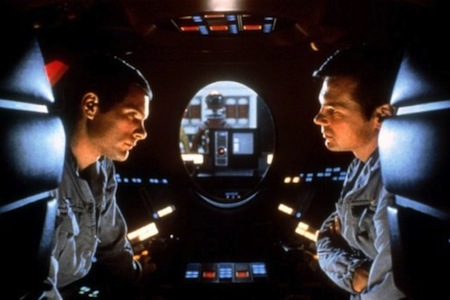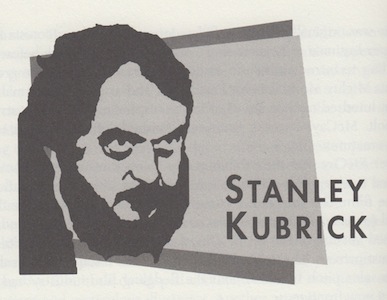Born: July 26, 1928, Bronx, NY
Died: March 7, 1999, Harpenden, England
2001 was a small step for Stanley Kubrick, but it was a giant leap for special effects.
—John Culhane
The celebrated career of director Stanley Kubrick is also one of the most enigmatic in cinema. A gifted artist and a tireless craftsman, Kubrick accumulated a body of work that is nearly impossible to compare to any other director’s in the history of the movies. His films defy categorization, and their elusive meanings often send the most articulate film buffs into rambling conjecture. Fans will speculate about hidden messages in dialogue, the symmetrical construction of his scenes and the obscure references to the director’s personal life tucked away in the subtext of the films. These curiosities are fueled by the mysterious behavior of this reclusive man. Kubrick shunned all discussion of his own pictures, preferring to let them communicate unencumbered by explanation. His strikingly powerful images are indelible, and his greatest contribution to film is the grand vision he consistently brings to the screen.
Stanley Kubrick spent his adolescence hauling around a copy of Vsevolod Pudovkin’s Film Technique and analyzing every shot and sequence of the classic films available for study at the Museum of Modern Art. His position as a staff photographer for Look magazine in 1950 afforded him the spare time and access to equipment that he needed to make a documentary film. Day of the Fight (1951), his first effort, was an interesting boxing picture, which Kubrick sold to RKO for a profit of $100. In 1955, while still an independent filmmaker, Kubrick made the highly stylized racetrack heist film The Killing (1956). Despite the presence of the controversial actor Sterling Hayden, who had appeared before a congressional hearing to “name names” of fellow actors who were sympathetic to Communist causes, the film received a positive critical reception, and Kubrick acquired enough financial backing for another project, Paths of Glory (1957), an antiwar film that started a career of intensely personal projects.
Paths of Glory, written by Kubrick and pulp-fiction novelist Jim Thompson, was a biting World War I drama about a French army commander forced by his egocentric superior to send his men into a futile battle situation. Early signs of the absurd and ironic narrative that Kubrick favors were already present. The notable casting of rebellious maverick Kirk Douglas continued a Kubrick trend of working with Hollywood “radicals.” A tense, tightly woven film of tremendous impact, Paths of Glory was the first step in the growth of the director’s unique vision.
Ironically, his next directorial effort was the sprawling Spartacus (1960), a film assigned to Kubrick by studio executives when it was already halfway through production. Kirk Douglas, the film’s star, clashed with director Anthony Mann and demanded that Kubrick take the helm. The script, by blacklisted screenwriter Dalton Trumbo from the bestselling novel by Howard Fast, lacked the characteristic Kubrick touches. Although the film would ambitiously tackle the subjects of homosexuality and religious persecution, it remains a slick and incongruous reminder that this was Kubrick’s first Hollywood assignment. Still, it was immensely popular and brought Kubrick offers for other films with unlimited creative freedom. But he turned his back on many of the prospects, choosing instead to make films on his own terms.
Leaving the United States for England, Kubrick began his next film at the Shepperton Studios in 1961. Dr. Strangelove, or: How I Learned to Stop Worrying and Love the Bomb (1964), perhaps the famous black comedy ever made, was taken from the novel Red Alert by Peter George. Kubrick and irreverent writer Terry Southern (who later conscripted the 1960s counterculture films Barbarella and Easy Rider) crafted a serious film about nuclear Armageddon, but after reading the first draft of the script, they found themselves laughing at the heavy irony and humor of the straightforward dialogue. With minor adjustments, they turned the film into a masterpiece of Cold War inanity. Timeless performances by Peter Sellers, George C. Scott, Sterling Hayden, Peter Sellers, Slim Pickens, Kennan Wynn and Peter Sellers made the film an instant success. It became a cult classic and—fueled by the rumors of Kubrick’s permanent status as an expatriate—was viewed as an American’s condemnation of his country’s military policies, specifically the anti-Communist witch-hunts and accelerated nuclear escalation.
For 2001: A Space Odyssey (1968), Kubrick became obsessed with nearly every B-movie adaptation of science fiction stories and began consulting a wide collection of scientists, computer experts, astronomers and engineers about their conceptions and philosophies in regard issues of space travel, technological progress and existentialism. He swore artists to the strictest secrecy before commissioning the $10.5 million worth of sets, costumes, music and scale models of futuristic spaceships for wide-screen CinemaScope presentation of the film. With its startling special effects and hypnotic visuals, 2001: A Space Odyssey updated the space exploration genre by light years. It was startling in so many ways. More than half of the film’s running time has no dialogue. Form takes precedence over plot. A deliberate tedium reinforces the main theme. Stark landscapes and lengthy establishing shots required unprecedented intellectual fortitude from the audience. The public and critical opinions of 2001 were extremely polarized.
But the film survived the initial reaction and was soon hailed as an extremely important cornerstone of modern filmmaking. Kubrick’s concepts of time and technology have remained influential to sci-fi movies for thirty years. The standards for visual special effects in the genre were raised incrementally. Thematically, it echoed our fears of technology’s pace, yet fueled our desires to learn more about artificial intelligence and planetary colonization. The frighteningly straightforward HAL computer revived the Frankenstein motif of a man-made creation run amok. The film simultaneously made all preceding science fiction films unsophisticated and ensured that all that followed had to live up to the technical and scientific expectations created by 2001, including the genre’s best efforts: THX 1138, Alien, Star Wars, War Games and Star Trek.
His other futuristic vision, A Clockwork Orange (1971), was more controversial but equally conceptual. Adapted from a novel by Anthony Burgess, the film’s grim and disturbing study in violence and governmental control not only challenged contemporary ideas but offered graphic metaphors that renewed the tremendous respect filmmakers have for Kubrick as a visual stylist.
Kubrick became more methodical and calculating with each project, producing just a handful of films over the next twenty-five years. His working methods are slow and painfully meticulous, and his legendary perfectionism frequently reaches a level of absurdity that cast and crew find intolerable. The shooting schedule for The Shining (1980) ran past two hundred days; for Eyes Wide Shut (1998), well beyond three hundred. His actors cite extreme emotional stress when Kubrick insists on lengthy retakes to match a visual picture that resides in his head. Tom Cruise was asked by Kubrick to repeat a scene ninety-three times before the director settled for a take he deemed adequate.
Questions remain as to whether Kubrick’s loyal fans have benefited from the large degree of creative freedom he has arranged for himself. Since A Clockwork Orange, the subsequent releases of the expatriate director were uneven and infrequent. The overlong Barry Lyndon (1975) was followed five years later by an adaptation of Stephen King’s novel The Shining. Between the wartime Full Metal Jacket (1987) and the most recent, Eyes Wide Shut, there was a span of more than ten years, during which Kubrick reportedly abandoned several films that were deep into production. His leisurely production pace may have caught up with him; he was perennially rumored to be making a film about artificial intelligence but experienced dramatic setbacks when the advances of new technology render his scripted material outdated. [Editor’s note: Steven Spielberg released A.I. in 2001, two years after Kubrick’s death.]
Eccentricities aside, Kubrick proved himself a unique talent in film history. He ranks with the few directors who can claim to have redefined an entire genre, and his vision of space exploration is still the pervasive one, both in theme and execution. George Lucas brought a number of interesting elements to the 2001 legacy (and ranks higher than Kubrick because of his substantial influence on film editing), but not since William Cameron Menzies’s Things to Come (1936) has an artist skillfully turned a series of fantastic images into an enduring worldview of the future.
To read all the republished articles from ‘The Film 100,’ go to Reintroducing the Film 100 here on Keyframe.





